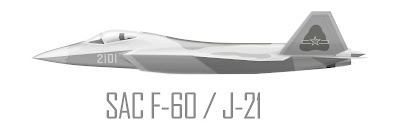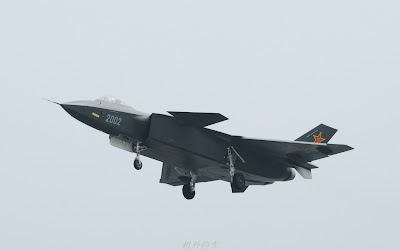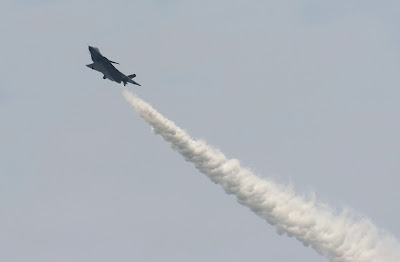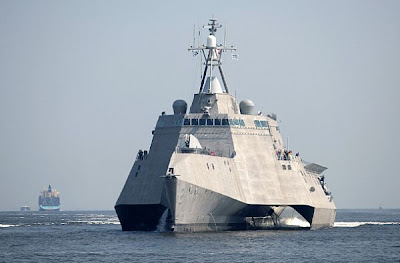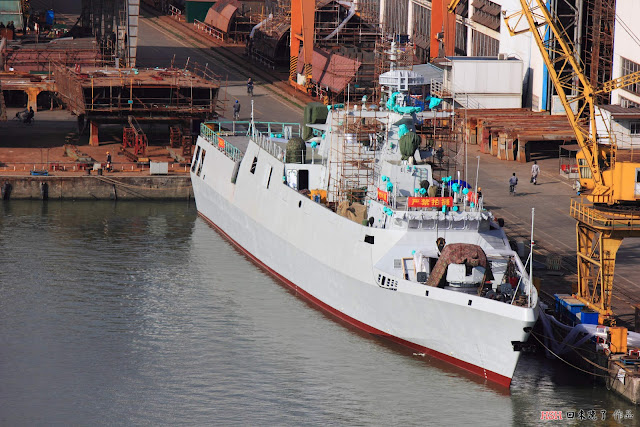Jun 29, 2012
Jun 25, 2012
Indian Navy to Induct 24 Long Range Maritime Reconnaissance Aircraft
The Indian Navy will acquire 12 more Long Range Maritime Reconnaissance
(LRMR) aircraft in addition to the 12 Boeing P8-I already ordered or
being ordered.
Chief of the Naval Staff Admiral Nirmal Verma told India Strategic in an interview that the Navy was satisfied with the progress of the first eight Indian P8-Is being built by Boeing under a 2009 order and that the second order for four more aircraft was being processed to be placed within the current fiscal ending March 2012.
The Government had cleared these 12 aircraft already as requested by the Navy, and at a later date, it was being planned to acquire 12 more LRMRs for offshore surveillance and protection of the Indian waters and interests, bringing the total to 24, he said.
Chief of the Naval Staff Admiral Nirmal Verma told India Strategic in an interview that the Navy was satisfied with the progress of the first eight Indian P8-Is being built by Boeing under a 2009 order and that the second order for four more aircraft was being processed to be placed within the current fiscal ending March 2012.
The Government had cleared these 12 aircraft already as requested by the Navy, and at a later date, it was being planned to acquire 12 more LRMRs for offshore surveillance and protection of the Indian waters and interests, bringing the total to 24, he said.
Russia Wants a Darpa Like Agency
Russian industry and defense leaders announced plans last week to
bankroll the Russian Foundation for Advanced Research Projects in the
Defense Industry. Russia’s newly re-coronated president, Vladimir Putin,
has already sent a bill to parliament to authorize the agency, which
will be tasked with keeping track of projects that “can ensure Russian
superiority in defense technology,” according to news service RIA
Novosti.
One possible location is near the Gromov Flight Research Institute — an experimental aircraft test base — to Moscow’s southeast. The future site, though, may also resemble the Skolkovo Innovation Center, a sort of Silicon Valley for Russia’s high-tech companies located on the city’s opposite end. But instead of focusing on civilian IT and biotech like at Skolkovo, the companies near Gromov would take charge of “all high-risk and fundamental research projects in the military-industrial complex,” Dmitry Rogozin, chief of Russia’s defense industry, said.
Basically, Russia wants to modernize, and needs its own far-out research department to do it. Its military is getting old and risks becoming dependent on other countries. It’s also a part of a larger Russian push for more military tech. And there’s no telling what projects the agency could come up with. Perhaps the agency, when open for business, can take on the task of controlling our minds and constructing robots that will keep the human brain alive forever.
One possible location is near the Gromov Flight Research Institute — an experimental aircraft test base — to Moscow’s southeast. The future site, though, may also resemble the Skolkovo Innovation Center, a sort of Silicon Valley for Russia’s high-tech companies located on the city’s opposite end. But instead of focusing on civilian IT and biotech like at Skolkovo, the companies near Gromov would take charge of “all high-risk and fundamental research projects in the military-industrial complex,” Dmitry Rogozin, chief of Russia’s defense industry, said.
Basically, Russia wants to modernize, and needs its own far-out research department to do it. Its military is getting old and risks becoming dependent on other countries. It’s also a part of a larger Russian push for more military tech. And there’s no telling what projects the agency could come up with. Perhaps the agency, when open for business, can take on the task of controlling our minds and constructing robots that will keep the human brain alive forever.
Russia Want To Closer Relationship With Pakistan
Russia, India's strongest international partner, is trying its hand at
engaging Pakistan, an exercise that will be watched carefully in New
Delhi.
Vladimir Putin, Russian president, will be in Islamabad on September 26 for a "quadrilateral" meeting with Tajikistan, Pakistan and Afghanistan on the future of Afghanistan. Putin will also have a first-ever bilateral summit in Islamabad along with the quadrilateral. The "quadrilateral" last met in Dushanbe in 2011. India and the US recently started a trilateral dialogue with Afghanistan to continue assisting Afghan development after the Nato withdrawal in 2014.
Indian analysts believe this visit could be the beginning of a deeper strategic realignment that brings together various intersecting interests.
Prabhat Shukla, former envoy to Russia, says, "The Russian policy of opening up to Pakistan is a well-settled response to a perceived opening up by India towards the US. We saw it in the late 1960s, again a decade later, and are seeing it being repeated now. If it ever made strategic sense in the 1960s, or even in the late 1970s, it certainly does not now."
Russia, though, is returning to what it calls its "near abroad". Primary is Russia's increasing interest in the stability of the Central Asian countries, many of whom are threatened by Islamic terrorism that has its roots in the terror groups inside Pakistan. Moscow might see a greater engagement with Islamabad as a way to understand Pakistan's actions. Russia's Pakistani initiative comes as Islamabad's relationship with its principal backer, the US, is determinedly heading south.
Ronen Sen, former envoy to Moscow and Washington, said, "This is a sign of the re-alignments in anticipation of the Afghanistan withdrawal."
Vladimir Putin, Russian president, will be in Islamabad on September 26 for a "quadrilateral" meeting with Tajikistan, Pakistan and Afghanistan on the future of Afghanistan. Putin will also have a first-ever bilateral summit in Islamabad along with the quadrilateral. The "quadrilateral" last met in Dushanbe in 2011. India and the US recently started a trilateral dialogue with Afghanistan to continue assisting Afghan development after the Nato withdrawal in 2014.
Indian analysts believe this visit could be the beginning of a deeper strategic realignment that brings together various intersecting interests.
Prabhat Shukla, former envoy to Russia, says, "The Russian policy of opening up to Pakistan is a well-settled response to a perceived opening up by India towards the US. We saw it in the late 1960s, again a decade later, and are seeing it being repeated now. If it ever made strategic sense in the 1960s, or even in the late 1970s, it certainly does not now."
Russia, though, is returning to what it calls its "near abroad". Primary is Russia's increasing interest in the stability of the Central Asian countries, many of whom are threatened by Islamic terrorism that has its roots in the terror groups inside Pakistan. Moscow might see a greater engagement with Islamabad as a way to understand Pakistan's actions. Russia's Pakistani initiative comes as Islamabad's relationship with its principal backer, the US, is determinedly heading south.
Ronen Sen, former envoy to Moscow and Washington, said, "This is a sign of the re-alignments in anticipation of the Afghanistan withdrawal."
Jun 19, 2012
India To Launch AWACS Project To Counter China
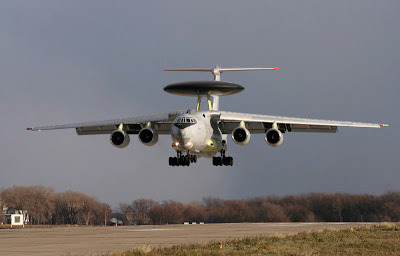 |
| Indian Phalcon AWACS |
In India Clearances are underway to initially develop two AWACS aircraft,
with four more to follow at a later stage, under the new `AWACS-India'
project to be executed by DRDO and its Bangalore-based Centre for Air
Borne Systems (CABS).
Under it, 360-degree AESA (active electronically scanned array) radars will be mounted on large aircraft like IL-76, Boeing or Airbus said a DRDO source.
Potent force-multipliers like AWACS or AEW&C (airborne early warning and control) systems have changed the entire nature of air warfare because they can detect incoming aerial threats, ranging from fighters to cruise missiles, much before ground-based radars.
They also serve to direct air defence fighters during combat operations with enemy jets and also help in tracking troop build-ups.
Pakistan already has four Swedish Saab-2000 AEW&C aircraft, with four more Chinese ZDK-03 AWACS in the pipeline. China has around 20 AWACS, a mix of new and old systems, say sources.
But IAF has only three Phalcon AWACS mounted on IL-76 aircraft, under the $1.1 billion tripartite agreement among India, Israel and Russia finalized in 2004, despite being confronted with two potentially hostile fronts.
The case for two additional "follow-on" Phalcon AWACS, with a range of over 400-km and 360-degree coverage like the first three, has run into some rough weather due to sharp cost escalation.
UFOs Seen Approaching Shenzhou 9 Rocket
 |
| UFO Near Shenzhou 9 Rocket |
TV viewers watching the Shenzhou 9 mission liftoff on Saturday evening
might have seen two UFOs approach the rocket as it exited the earth's
atmosphere.
Video recorded by infrared cameras revealed two shining objects rapidly moving toward the rocket from opposite sides of the Long March 2F rocket about four minutes and 11 seconds after liftoff.
The objects could not have been stars as none were visible during the 6:37 pm launch time, said Wang Sichao, a researcher at the Purple Mountain Observatory in Nanjing, Jiangsu Province.
Wang ruled out the possibility the objects were parts of the rocket, as they appeared ahead of its trajectory, as well as the theory they were birds since the objects left extremely visible heat signatures.
Video recorded by infrared cameras revealed two shining objects rapidly moving toward the rocket from opposite sides of the Long March 2F rocket about four minutes and 11 seconds after liftoff.
The objects could not have been stars as none were visible during the 6:37 pm launch time, said Wang Sichao, a researcher at the Purple Mountain Observatory in Nanjing, Jiangsu Province.
Wang ruled out the possibility the objects were parts of the rocket, as they appeared ahead of its trajectory, as well as the theory they were birds since the objects left extremely visible heat signatures.
Indian RAW Operating Against Pakistan
According to a daily “The News” more than 100 Pakistani Baloch
dissidents have been sent to India by the Indian consulate located in
Kandhar (Afghanistan) for six-months training. These people were
selected from areas bordering Pakistan as well as Baloch nationals
residing in different camps in Kandhar. They have been promised a salary
of $ 500- 1,000 on their return to Afghanistan. They will be imparted
training in the fields of sniper shooting, handling of technical
equipment such as GPS, wireless sets and intelligence gathering
techniques. The handlers of the dissident Baloch elements plan to assign
different targets in Baluchistan and Sindh provinces to the trained
Baloch militants for sabotage and terrorist activities.
Ever since the Taliban were ousted from power and foreign troops landed in Afghanistan in late 2001, the Indians have been using the Afghan soil for sabotage and terrorist acts in Pakistan. Since 9/11, Indian influence has increased tremendously. India is following the strategy of the encirclement of Pakistan by making Afghanistan into a vocal anti-Pakistan client state with five very active Indian consulates along the Pak-Afghan border to destabilize Baluchistan and North West Frontier Province (NWFP). RAW has organized a network of training schools throughout Afghanistan. Some of these training centers are operating in Kabul, Jalalabad , Khawaja Ghar (Takhar Province), Khost, Paktia, Urgun, Kandhar, Spin Boldak and Dranj (Badakhshan Province). All these training centers are being used for indoctrinating minds of innocent people of FATA and Balochistan to work against Pakistan. Refugee camps for Balochistan dissidents have been established in bordering towns of Kandhar, Spin Bodlak, Helmond and Nirmoz where RAW has been given free access to interact for spotting and cultivating them. RAW with the help of local officials is providing financial support to Barhamdagh Bughti for undertaking terrorist activities in Balochistan. Spin Blodak is said to be the main hub of anti-Pakistan activities and the town is being used as a launching pad. RAW-RAAM used to providing weapons via Bajaur, Dir, Pewchar. In order to subvert loyalties of young generation, young Baloch students are spotted through senior Balochistan Student organization (BSO) hardliners, taken to Kabul for indoctrination, issued with Afghan passports and selected individuals then dispatched to training centers in various countries.
Ever since the Taliban were ousted from power and foreign troops landed in Afghanistan in late 2001, the Indians have been using the Afghan soil for sabotage and terrorist acts in Pakistan. Since 9/11, Indian influence has increased tremendously. India is following the strategy of the encirclement of Pakistan by making Afghanistan into a vocal anti-Pakistan client state with five very active Indian consulates along the Pak-Afghan border to destabilize Baluchistan and North West Frontier Province (NWFP). RAW has organized a network of training schools throughout Afghanistan. Some of these training centers are operating in Kabul, Jalalabad , Khawaja Ghar (Takhar Province), Khost, Paktia, Urgun, Kandhar, Spin Boldak and Dranj (Badakhshan Province). All these training centers are being used for indoctrinating minds of innocent people of FATA and Balochistan to work against Pakistan. Refugee camps for Balochistan dissidents have been established in bordering towns of Kandhar, Spin Bodlak, Helmond and Nirmoz where RAW has been given free access to interact for spotting and cultivating them. RAW with the help of local officials is providing financial support to Barhamdagh Bughti for undertaking terrorist activities in Balochistan. Spin Blodak is said to be the main hub of anti-Pakistan activities and the town is being used as a launching pad. RAW-RAAM used to providing weapons via Bajaur, Dir, Pewchar. In order to subvert loyalties of young generation, young Baloch students are spotted through senior Balochistan Student organization (BSO) hardliners, taken to Kabul for indoctrination, issued with Afghan passports and selected individuals then dispatched to training centers in various countries.
Jun 17, 2012
Saudi Arabia Wants To Buy 600-800 Leopard Tanks
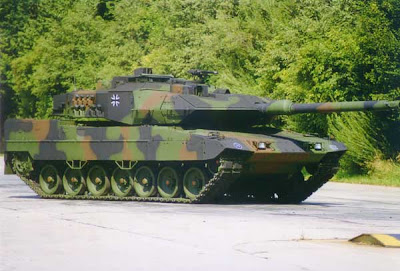 |
| Leopard 2 Tank |
Saudi Arabia wants to buy 600 to 800 Leopard battle tanks from
Germany, at least twice the number previously expected, a German
newspaper reported on Sunday.
A deal for around 300 tanks was about to be signed, Bild am
Sonntag newspaper said in a report sent to Reuters ahead of publication.
The newspaper said that while there was opposition to the deal in
Germany’s Chancellery, Foreign Ministry and Defence Ministry, there was
support for it within the Economy Ministry.
“The Saudi order could secure the future of German tank-makers
Krauss-Maffei Wegman and Rheinmetall, which urgently need new markets
because of the restructuring of the German army,” said Bild am Sonntag.
A German government spokeswoman declined to comment.
IAF To Upgrade Its Fighter Pilots Training Programme
From 2013 onwards, IAF will kick off a major upgrade in
its entire training programme for pilots who go on to fly
expensive top-notch fighter jets, transport aircraft and helicopters.
Better initiation into the intricacies of combat flying, inherently dangerous in contrast to civil aviation, is critical for new pilots since over 39% of the 1,010 crashes recorded by IAF since 1970 have been attributed to "human error (aircrew)".
Forced to drastically cut down the quantum of flying for pilots to only 25 hours in Stage-I "basic" training for the last three to four years due to acute shortage of trainer aircraft, IAF now plans to ramp it up to 65 flying hours, with an additional 25 hours on advanced simulators.
This will be possible with fast-track induction of 75 Swiss Pilatus PC-7 basic trainer aircraft (BTA) under the Rs 2,900- crore deal inked last month after a long delay. "The Swiss have promised to begin deliveries by next January itself," said a senior officer.
"So, we will begin the first course in July 2013 with the first 14 Pilatus trainers we get. Full-scale basic training of all new pilots on Pilatus will begin from January, 2014," he added.
Stage-II "intermediate" training on Kiran aircraft for fighter pilots will involve 82 hours, while another 107 hours will be clocked in Stage-III "advanced" training on Hawk AJTs (advanced jet trainers).
In effect, rookie pilots will then log 254 hours of actual flying, apart from simulator training. It takes Rs 11 crore to train a single fighter pilot, and around half that amount for a chopper or a transport aircraft.
Training schedules of IAF, which inducts 240 new trainee pilots annually, went haywire after the entire fleet of the 114 ageing piston-engine HPT-32 aircraft, which long served as the BTA, was grounded in August, 2009, after a crash killed the pilot.
IAF also has to get a replacement for the 80 virtually obsolete Kirans — currently used for both Stage-I and Stage-II training — that can be "stretched" only till 2015. By then, Hindustan Aeronautics (HAL) will have to deliver on its long-delayed project to manufacture 85 IJTs.
Better initiation into the intricacies of combat flying, inherently dangerous in contrast to civil aviation, is critical for new pilots since over 39% of the 1,010 crashes recorded by IAF since 1970 have been attributed to "human error (aircrew)".
Forced to drastically cut down the quantum of flying for pilots to only 25 hours in Stage-I "basic" training for the last three to four years due to acute shortage of trainer aircraft, IAF now plans to ramp it up to 65 flying hours, with an additional 25 hours on advanced simulators.
This will be possible with fast-track induction of 75 Swiss Pilatus PC-7 basic trainer aircraft (BTA) under the Rs 2,900- crore deal inked last month after a long delay. "The Swiss have promised to begin deliveries by next January itself," said a senior officer.
"So, we will begin the first course in July 2013 with the first 14 Pilatus trainers we get. Full-scale basic training of all new pilots on Pilatus will begin from January, 2014," he added.
Stage-II "intermediate" training on Kiran aircraft for fighter pilots will involve 82 hours, while another 107 hours will be clocked in Stage-III "advanced" training on Hawk AJTs (advanced jet trainers).
In effect, rookie pilots will then log 254 hours of actual flying, apart from simulator training. It takes Rs 11 crore to train a single fighter pilot, and around half that amount for a chopper or a transport aircraft.
Training schedules of IAF, which inducts 240 new trainee pilots annually, went haywire after the entire fleet of the 114 ageing piston-engine HPT-32 aircraft, which long served as the BTA, was grounded in August, 2009, after a crash killed the pilot.
IAF also has to get a replacement for the 80 virtually obsolete Kirans — currently used for both Stage-I and Stage-II training — that can be "stretched" only till 2015. By then, Hindustan Aeronautics (HAL) will have to deliver on its long-delayed project to manufacture 85 IJTs.
Jun 15, 2012
China's Norinco New MBT-3000 Tank
 |
| Norinco New MBT-3000 Tank |
China’s North Industries Corporation (NORINCO) also displayed their Main
Battle Tank 3000 the company hopes to deliver to the Chinese Army in
two years, Cheng said. It’s one of the few, if not the only, company to
be developing a main battle tank.
The tank can reach speeds up to 42 miles per hour with a cruising range of 500 km. It has a fording depth of four to five meters and a trench of 2.7 meters. The maximum gradient is 60 percent.
Engineers mounted a 125mm smoothbore gun onto the MBT 3000. The main gun can fire APFSDS, HEAT and HE shells and gun launched missiles with a maximum missile range reaching 5,000 meters.
MBT 3000 also features a 12.7 mm anti-aircraft machine gun and a 7.62mm coaxial machine gun. Tankers can also fire from 8 76mm smoke grenade launchers and 4 76mm shrapnel grenade launchers.
Russian 4th T-50 Stealth Fighter To Fly
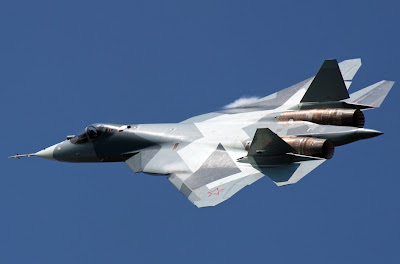 |
| T-50 |
Russia's United Aircraft Corporation is to introduce a 4th
Sukhoi T-50 stealth fighter into its test and development program this
year, the company's President Mikhail Pogosyan said on Thursday.
"We are now testing three aircraft. A 4th will be brought in this year," he said.
Pogosyan had said earlier this year that the firm would introduce a fourth aircraft into the test program but did not disclose when.
The first production standard T-50 is due to enter service with the Russian Air Force by 2015, and the first evaluation example by 2013. The service plans to acquire 60 of the fifth-generation fighters.
"We are now testing three aircraft. A 4th will be brought in this year," he said.
Pogosyan had said earlier this year that the firm would introduce a fourth aircraft into the test program but did not disclose when.
The first production standard T-50 is due to enter service with the Russian Air Force by 2015, and the first evaluation example by 2013. The service plans to acquire 60 of the fifth-generation fighters.
Jun 13, 2012
China Has Hacked Every Major US Company---Richard Clarke
Richard Clarke, a former cybersecurity and cyberterrorism advisor for
the White House, was a U.S. government employee for 30 years: between
1973 and 2003. He worked during the times of Ronald Reagan, George H.W.
Bush, Bill Clinton, and even George W. Bush. He may not be working under
current U.S. president Barack Obama, but that doesn’t mean he doesn’t
have something to warning about. He says state-sanctioned Chinese
hackers are stealing R&D from U.S. companies, threatening the
long-term competitiveness of America. We’ve heard this before, but the
way Clarke puts it makes the situation look even more dire.
“I’m about to say something that people think is an exaggeration, but
I think the evidence is pretty strong,” Clarke said during an interview.
“Every major company in the United States has already been penetrated
by China. My greatest fear is that, rather than having a cyber-Pearl
Harbor event, we will instead have this death of a thousand cuts. Where
we lose our competitiveness by having all of our research and
development stolen by the Chinese. And we never really see the single
event that makes us do something about it. That it’s always just below
our pain threshold. That company after company in the United States
spends millions, hundreds of millions, in some cases billions of dollars
on R&D and that information goes free to China.After a while you
can’t compete.”
Russia, Israel Negotiating Joint-UAV Project
Russia and Israel are negotiating a joint project to build an unmanned aerial vehicle, Russian Deputy Prime Minister Dmitry Rogozin said on Wednesday.
“We are negotiating with Israel. Our aim is to persuade them to start
technological cooperation and to develop a product that will be used in
both countries, and could also be sold to third countries,” Rogozin said
in an interview with the Rossia-24 TV channel.
Russia will no
longer buy ready-made weapon systems in the West but is only interested
in new technology, said Rogozin, who is responsible for Russia's
military-industrial complex.
“Technology should be attracted by localizing production on Russian territory,” Rogozin noted.
In mid-May a source in the Russian defense industry said Moscow may buy
a large new consignment of unmanned aerial vehicles from Israel and 24
command and control systems worth around $50 million in the foreseeable
future.
Australia Plans To Get More F/A-18F Super Hornets
 |
| F/A-18F Super Hornets |
Australian defense officials are set to go to the USA this week for an
update from Lockheed Martin, the manufacturer of the JSF F-35 Lightening
II, about the delivery schedule of the F-35 jets.
The country plans to buy up to 100 F-35 fighters and has placed an initial order for 14. The Royal Australian Air Force was expected to induct the first batch of F-35 advanced stealth fighters by 2018.
However, the US Air Force too is buying the same variant of the Joint Strike Fighter as the RAAF and has pushed back the dates by which it expects to have its first squadrons operational from mid-2016 to 2017 -- and possibly now to mid-2018, the news report said.
Despite assurances from Lockheed Martin that the first 14 fighters will be delivered to it on time, Australian defense officials believe that deployment of the new generation fighters in the RAAF would not happen before 2020 or even later.
The country plans to buy up to 100 F-35 fighters and has placed an initial order for 14. The Royal Australian Air Force was expected to induct the first batch of F-35 advanced stealth fighters by 2018.
However, the US Air Force too is buying the same variant of the Joint Strike Fighter as the RAAF and has pushed back the dates by which it expects to have its first squadrons operational from mid-2016 to 2017 -- and possibly now to mid-2018, the news report said.
Despite assurances from Lockheed Martin that the first 14 fighters will be delivered to it on time, Australian defense officials believe that deployment of the new generation fighters in the RAAF would not happen before 2020 or even later.
Jun 11, 2012
India To Buy 8 Warships From South Korea
India is to acquire at least eight warships from South Korea in a
bid to bolster its maritime defense, under a proposed defense deal
likely to be inked soon, local media reported.
As part of a growing "strategic partnership" with South Korea, India
will buy at least eight advanced minesweeping and hunting warships -- it
will get two of the vessels from South Korean firm Kangnam Corporation,
while the other six will be manufactured by Goa Shipyard in western
India after transfer of technology, 'The Times of India' newspaper
reported.
"The contract is now being finalized after the conclusion of the
commercial negotiations," an unnamed source was quoted as saying.
India will used these warships to detect and destroy underwater
mines, often planted by both state as well as non-state actors, the
report said.
Jun 10, 2012
USA Frightens China With Super Destroyer
The U.S. is building "the most advanced" warship in history - DDG-1000
destroyer of Zumwalt class that the Pentagon called a "super-stealth
silver bullet." It will be able to move quietly along the coast,
including in the shallows, hitting the targets of the enemy with
electromagnetic rail guns, deceiving enemy radars.
Americans plan to equip its fleet in the Asia-Pacific region with these ships "from sci-fi movies". It is to the shores of China frightening with the increase of its military where the Pentagon intends to relocate 60% of its ships in 2020 in the framework of the renewed military strategy.
The new destroyers are being built in Maine, the first will be launched as early as 2014, the Associated Press reported. Visiting the local shipyard in April, the head of Naval Operations Adm. Jonathan Grinert praised the ships, saying that they would be the hope in the future. He listed the main advantages: "invisibility", an advanced sonar system, the incredible striking power and small crew size.
Pentagon chief Leon Panetta, announcing at a regional security conference in Singapore the change to the U.S. military strategy, said that the new high-tech vessel will be a significant part of the U.S. Pacific grouping.
The stealth destroyers could be useful in other regions, such as the Persian Gulf, but the military believe that they will be most beneficial in Asia. The new ships will be able to perform the mission both in the high seas and near the coast. In Asia there are a great number of island States, and China has a long coastline in the Pacific.
Americans plan to equip its fleet in the Asia-Pacific region with these ships "from sci-fi movies". It is to the shores of China frightening with the increase of its military where the Pentagon intends to relocate 60% of its ships in 2020 in the framework of the renewed military strategy.
The new destroyers are being built in Maine, the first will be launched as early as 2014, the Associated Press reported. Visiting the local shipyard in April, the head of Naval Operations Adm. Jonathan Grinert praised the ships, saying that they would be the hope in the future. He listed the main advantages: "invisibility", an advanced sonar system, the incredible striking power and small crew size.
Pentagon chief Leon Panetta, announcing at a regional security conference in Singapore the change to the U.S. military strategy, said that the new high-tech vessel will be a significant part of the U.S. Pacific grouping.
The stealth destroyers could be useful in other regions, such as the Persian Gulf, but the military believe that they will be most beneficial in Asia. The new ships will be able to perform the mission both in the high seas and near the coast. In Asia there are a great number of island States, and China has a long coastline in the Pacific.
INS Vikramaditya Begins Sea Trials
INS Vikramaditya aircraft carrier took to the sea for the first time on Friday.
The carrier sailed out for crucial pre-delivery trials in the early
hours of June 8 from the berth of the Sevmash shipyard in Russia’s
northern city of Severodvinsk, where the former Soviet heavy aviation
cruiser Gorshkov had been converted into a regular aircraft carrier
christened Vikramaditya.
During the trials, scheduled to last 120 days, all the ship’s systems will be tested.
“The main part of the trials is testing aircraft takeoff and landing,” Sevmash chief Andrei Dyachkov told.
“The programme of tests is very tight as deck aviation can operate only
from June to September in the harsh conditions of Arctic seas.”
The test flights will be carried out using two Russian aircraft, MiG-29K
and MiG-35, flown by Russian pilots. Russia last year delivered to the
Indian Navy 12 MiG-29K single-seaters and 4 MiG-29KUB two-seaters, which
will be based on the Vikramaditya. India has ordered another batch of
29 MiG-29K deck fighters that will also provide airpower for the Vikrant
aircraft carrier being built in India.
Jun 9, 2012
Russia And China Will Increase Military Co-operation
Russian President Vladimir Putin emphasized burgeoning military ties
with China on Wednesday on the second day of a visit to his nation's
eastern neighbor.
Putin told Vice President Xi Jinping that he and Chinese President Hu
Jintao have vowed to expand military exchanges and he also recalled
recent Russian-Chinese naval exercises in the Yellow Sea.
Military exchanges between Moscow and Beijing have accelerated under a
regional security grouping that has hosted regular border protection and
anti-terrorism drills.
China is a major customer for Russian fighters, submarines, missiles
frigates, and other high-tech arms, but mistrust lingers from their Cold
War rivalry. Ties have warmed steadily, however, over Putin's
decade-long dominance of Russian political life.
Putin's visit is his first to China since returning to Russia's
presidency last month and comes ahead of his first visit to the U.S. in a
move seen as signaling an eastward pivot in Russian foreign policy.
In Beijing, Putin reaffirmed targets of raising bilateral trade to $100
billion by 2015 from $83.5 billion last year, and to $200 million by
2020.
Chinese Experts Say India Will Not Ally With US Against Beijing
Chinese analysts say that US efforts to make India part of its alliance
against China will not succeed India pursued independent foreign policy
focusing on its national interests.
US defence secretary Leon Panetta's visit to New Delhi is as part of Washington's efforts to make it part of alliance against Beijing but India's interest lie with Beijing, Wang Dehua, a specialist on South Asia studies at the Shanghai Institute for International Studies said.
"It seems that the US is sparing no efforts in forging a semi-circle of alliance against China from the South" as Panetta has attended the Shangri-La Dialogue in Singapore and afterward visited Vietnam and India, Wang, a specialist on South Asia told state-run Global Times which carried an article highlighting Panetta's visit to New Delhi.
"But India has its own agenda in the region," Wang said noting that India wants to be independent in making its own foreign policies while maximising its national interests.
"For example, India has refrained from becoming deeply involved in the South China Sea rows because it viewed any friction with China as being against its fundamental national interests," Wang said.
US defence secretary Leon Panetta's visit to New Delhi is as part of Washington's efforts to make it part of alliance against Beijing but India's interest lie with Beijing, Wang Dehua, a specialist on South Asia studies at the Shanghai Institute for International Studies said.
"It seems that the US is sparing no efforts in forging a semi-circle of alliance against China from the South" as Panetta has attended the Shangri-La Dialogue in Singapore and afterward visited Vietnam and India, Wang, a specialist on South Asia told state-run Global Times which carried an article highlighting Panetta's visit to New Delhi.
"But India has its own agenda in the region," Wang said noting that India wants to be independent in making its own foreign policies while maximising its national interests.
"For example, India has refrained from becoming deeply involved in the South China Sea rows because it viewed any friction with China as being against its fundamental national interests," Wang said.
Jun 4, 2012
Pakistan Test Fired Cruise Missile Hatf VII Babur: ISPR
 |
| Cruise Missile Hatf VII Babur |
Pakistan
on Tuesday conducted a successful test fire of the multi-tube,
indigenously developed Cruise Missile Hatf-VII (Babur), having a range
of 700 km.
According to ISPR statement, Babur Cruise Missile
is a low flying, terrain hugging missile with high maneuverability, pin
point accuracy and radar avoidance features.
It can carry both
nuclear and conventional warheads and has stealth capabilities. It also
incorporates the most modern cruise missile technology of Terrain
Contour Matching (TERCOM) and Digital Scene Matching and Area
Co-relation (DSMAC), which enhances its precision and effectiveness
manifolds.
The missile was launched from a state of the art multi
tube Missile Launch Vehicle (MLV) which significantly enhances the
targeting and employment options of Babur Weapon System in both the
conventional and nuclear modes.
Jun 2, 2012
Pakistan Succesful Test Fired Hatf-VIII Ra'ad ALCM
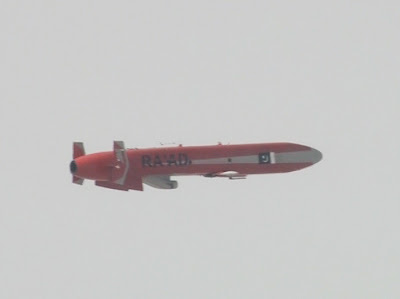 |
| Hatf -VIII Ra'ad ALCM |
Pakistan Conducted a Successful Flight Test of the indigenously developed Air Launched Cruise Missile, Hatf-VIII (Ra’ad).
The Ra’ad Missile, with a range of over 350 KM, enables Pakistan to
achieve strategic standoff capability on land and at Sea. ‘Cruise
Technology’ is extremely complex and has been developed by only a few
countries in the world. The state of the art Ra’ad Cruise Missile with
Stealth Capabilities is a Low Altitude, Terrain Hugging Missile with
high maneuverability, and can deliver nuclear and conventional warheads
with pin point accuracy.
A major additional feature of today’s test was the effective employment of the National Command Authority’s fully automated Strategic Command and Control Support System (SCCSS). It has enabled robust Command and Control capability of all strategic assets with round the clock situational awareness in a digitized network centric environment to decision makers at National Command Centre (NCC). The system has the added capability of real time remote monitoring of missile flight path.
Subscribe to:
Comments (Atom)
-
Pakistan has witnessed new defense acquisitions in this decade than any other, and in the center of it all is the new fighter which ...
-
China's Stealth Helicopter It's a stealth heavy attack helicopter. US aviation experts say that it is designed to cou...
-
The terrorist attack on Karachi's Mehran Naval Station on May 22 was conceived and launched by India with the primary objective o...
